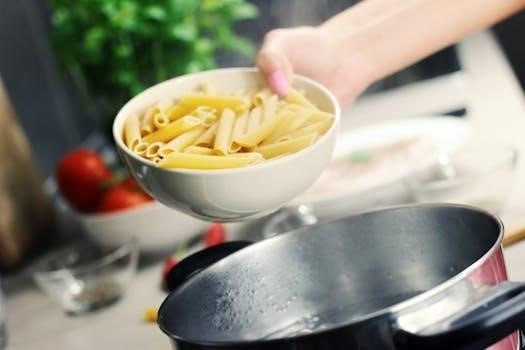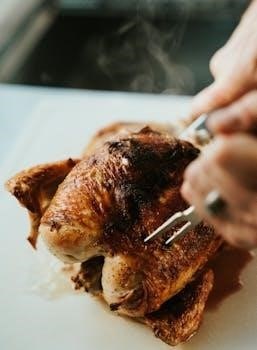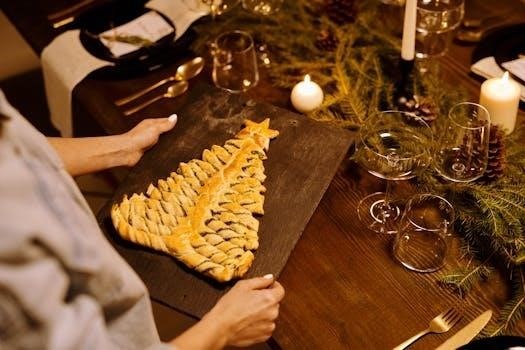Oven Preparation⁚ Initial Steps
Begin by preheating your oven to the recommended temperature of 400°F (200°C). This ensures even cooking and a perfectly crisp crust. Remove the pot pie from all packaging, including plastic wrap.
Preheating the Oven
The first crucial step in baking a Marie Callender’s chicken pot pie is to ensure your oven is properly preheated. For optimal results, set your oven to 400°F (200°C). This precise temperature is vital for even cooking of the pot pie, guaranteeing that the crust becomes golden brown and flaky while the filling heats thoroughly. Allow the oven to reach the desired temperature before placing the pot pie inside; this may take some time, depending on your oven model. A preheated oven prevents uneven cooking and helps the crust achieve its intended texture. It’s essential not to rush this step, as it significantly impacts the final outcome of your delicious meal.
Baking Process
Carefully place the unwrapped pot pie on a baking sheet. This will catch any potential spills during baking. Then, bake it in the preheated oven according to package directions.
Baking Time and Temperature
For optimal results when baking a Marie Callender’s chicken pot pie, it’s crucial to adhere to the correct baking time and temperature. Generally, the oven should be preheated to 400°F (200°C). This temperature ensures the pot pie cooks evenly, achieving a golden-brown crust and a thoroughly heated filling. The baking time typically ranges from 40 to 70 minutes, depending on the size and specific type of pot pie. It is essential to monitor the pie closely during the final stages of baking to prevent over-browning. Always refer to the specific instructions on the pot pie’s packaging, as there may be slight variations. A reliable food thermometer should be used to verify that the internal temperature reaches 165°F (74°C) for safety.
Placement on Baking Sheet
When preparing a Marie Callender’s chicken pot pie for baking, proper placement on a baking sheet is crucial to ensure even cooking and prevent any potential mess in your oven. Always place the pot pie on a baking sheet before placing it in the preheated oven. This step is essential for two reasons⁚ firstly, it helps catch any bubbling filling that might escape during the baking process, preventing it from burning onto the bottom of your oven. Secondly, using a baking sheet also helps distribute the heat more evenly around the pot pie, promoting uniform cooking of the crust and filling. Avoid placing the pot pie directly on the oven rack, as this can lead to uneven heating and potential spills. A rimmed baking sheet is recommended for catching any drippings.

Doneness Indicators
To determine if the pot pie is fully cooked, check for a golden brown crust and a bubbling filling. The internal temperature should reach 165°F, measured with a food thermometer.
Internal Temperature Check
Ensuring the internal temperature of your Marie Callender’s chicken pot pie reaches 165°F (74°C) is crucial for food safety. Use a food thermometer to check the temperature in several spots, especially in the center and thickest part of the filling. This step is non-negotiable to guarantee that the pot pie is thoroughly cooked, eliminating any risk of foodborne illness. Remember that relying solely on visual cues may not be sufficient, as some areas of the pot pie can heat up faster than others. Accurate temperature measurement is paramount for a safe and enjoyable meal. When in doubt, always err on the side of caution and ensure that 165°F is reached.
Crust Appearance
A perfectly baked Marie Callender’s chicken pot pie will boast a crust that is a deep, golden brown color. This visual cue indicates that the pie has been heated sufficiently. Look for an even browning across the entire surface of the crust, avoiding any pale or undercooked areas. The crust should also appear flaky and slightly puffed up, signifying that it is crisp and well-baked. Uneven browning or a soggy appearance can suggest that the pie requires additional cooking time. The edges of the crust are particularly important to observe; they should be a rich golden hue, confirming that the entire pie is cooked thoroughly. This visual check is a reliable indicator of doneness and a sign of a delicious meal awaiting.
Visual Cues⁚ Steam
Observing steam is a vital visual cue that indicates your Marie Callender’s chicken pot pie is reaching the proper temperature and is likely cooked through. As the pie bakes, steam should visibly rise from the filling, often escaping through any vents or cracks in the crust. This steam is a sign that the internal ingredients are heated and bubbling, a key aspect of doneness. The steam should be consistent and not intermittent. If you see little or no steam, it might mean the pie needs more time in the oven. Be careful when observing the steam, as it will be very hot. This visual clue, combined with other indicators, helps ensure a well-cooked, safe, and satisfying meal.

Post-Baking Procedures
After baking, carefully remove the pot pie from the oven using oven mitts. Allow it to cool for a few minutes before serving. This prevents burns from the hot filling.
Cooling Time
Allowing the Marie Callender’s chicken pot pie to cool after baking is a crucial step that should not be overlooked. Once removed from the oven, the internal temperature of the pie is extremely high, and the filling is molten. A cooling period of approximately 5 to 10 minutes is recommended to allow the filling to slightly solidify and the temperature to reduce to a safer level. This will prevent potential burns when serving or consuming the pie. This resting time also allows the flavors to meld together, enhancing the overall taste of the pot pie. It’s best to resist the urge to cut into it immediately; patience during this step will greatly improve your dining experience.
Serving Instructions
After the necessary cooling time, carefully transfer the Marie Callender’s chicken pot pie onto a plate or serving dish. Due to the high internal temperature, it is advisable to use oven mitts or a kitchen towel to handle it. The pot pie can be served whole or sliced into portions, depending on preference and the number of servings desired. When cutting the pie, be mindful of the hot filling, which can still be quite molten. It is essential to serve the pot pie while it is still warm to fully enjoy the combination of the flaky crust and savory filling. You may choose to serve it with a side salad or other complementary dishes.

Alternative Cooking Methods
While the oven is the most common method, a convection oven offers a quicker cooking time. Air fryers can also be used with some adjustments to temperature and time.
Convection Oven Instructions
For those opting for a convection oven, preheat it to a slightly lower temperature of 375°F (190°C). This adjustment is due to the circulating air in convection ovens, which often leads to faster cooking times. Place the Marie Callender’s pot pie directly onto a baking sheet to catch any potential drips during the baking process. The cooking time in a convection oven is generally shorter, typically ranging from 30 to 35 minutes. Monitor the pot pie closely, and make sure the crust is golden brown and the filling is bubbling hot before removing it. This is very important to make sure that the meal is properly cooked through, and hot enough to eat. Always use oven mitts or a kitchen towel to protect yourself from burns.
Air Fryer Considerations
Cooking a Marie Callender’s pot pie in an air fryer requires some adjustments from traditional oven baking. Due to the smaller cooking space and more concentrated heat, it’s crucial to use a lower temperature setting. Start by preheating your air fryer to 325°F (160°C). Place the pot pie carefully in the air fryer basket, making sure it fits without touching the sides or the heating element. It’s also very important to monitor the cooking process closely, since air fryers tend to heat up much quicker than conventional ovens. Air frying should take a little less time, typically around 30 minutes. Check that the crust is golden brown and the filling is bubbly. Using a food thermometer is a good idea to ensure it’s cooked through.

Additional Information
Marie Callender’s offers both individual and family-sized pot pies. Cooking times may vary, so always follow package directions for the best results. Leftovers can be stored properly for later enjoyment.
Family Size Pot Pie
When preparing a Marie Callender’s family-size chicken pot pie, it’s crucial to note that the baking time will typically extend compared to individual portions. Expect a cooking duration of approximately 60 to 70 minutes, or even up to 80 minutes, in a preheated oven. Always adhere to the specific instructions provided on the packaging to ensure thorough cooking. The internal temperature of the filling must reach 165°F (74°C) for safety, which can be verified using a food thermometer. The crust should be a deep, golden brown, and the filling should be bubbling hot before removing it from the oven. Allowing a brief resting period after baking is important, as it allows the filling to set and the temperature to equalize, making it easier and safer to serve. Remember, proper cooking ensures a satisfying and safe meal for your entire family.
Microwave Cooking Option
While the oven is the preferred method for achieving a golden, flaky crust, a microwave provides a quicker alternative for cooking Marie Callender’s chicken pot pie. It’s important to note that the crust may not reach the same level of crispness as with oven baking. When using a microwave, follow the specific instructions on the pot pie’s packaging for the appropriate cooking time, typically shorter than oven baking. Be sure to use a microwave-safe dish or container, and vent the packaging as directed. After microwaving, let the pot pie stand for a few minutes to allow the internal temperature to equalize. It is crucial to ensure that the filling is thoroughly heated to a safe temperature before consuming. Keep in mind that a microwave-cooked pot pie will have a softer crust than one baked in the oven. This method is best used when time is of the essence and a crispy crust is not a priority. Always check for hot spots and ensure the food is evenly heated.